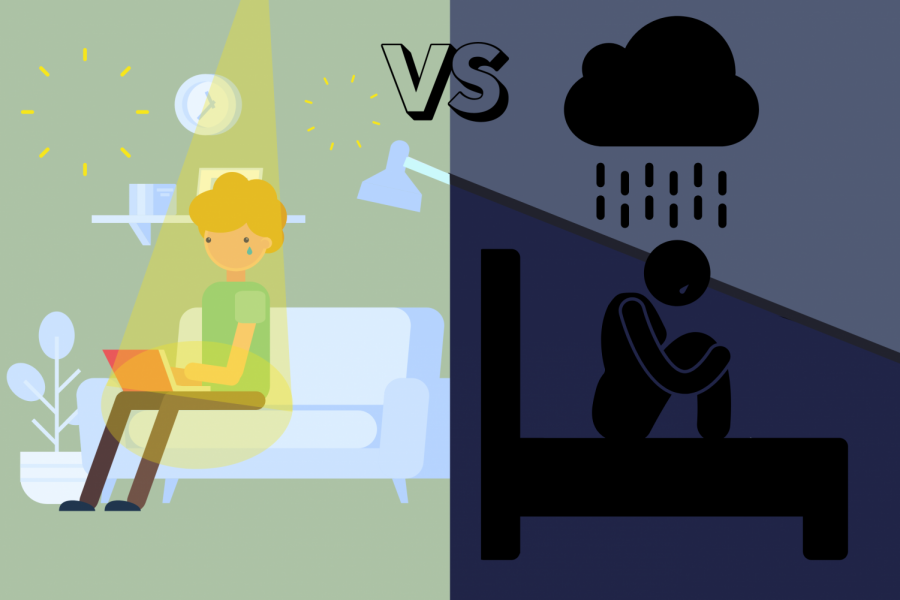‘There’s nothing romantic about that’: The media must stop glamorizing mental illness
Mental health depictions on screen seldom match the darker impacts of real life mental illnesses.
March 8, 2021
Content warning: this article contains language pertaining to drug use and suicide.
Some names have been changed to protect students’ privacy.
After the Netflix drama “13 Reasons Why” aired in 2017, critics denounced the show, maintaining that the disturbing plotlines could harm the mental health of viewers. In the program, the protagonist graphically commits suicide.
Around the world, stories began to surface of people taking their own lives in the same manner as the “13 Reasons Why” protagonist. Even some Whitman staff expressed concern about the content and popularity of the show, emailing parents to prevent their kids from watching it.
“In a lot of people’s minds, [the show] makes them think that if they kill themselves that people will finally pay attention to them,” said Mary (‘20), who struggles with depression and anxiety. “The reality is that most people that kill themselves do not do it for attention.”
“13 Reasons Why” is just one of many examples of the media portraying mental illness as a means of getting attention. Many TV shows and movies make mental illnesses seem like something desirable, or even something attractive. The romanticism of mental illness hurts people who actually suffer from it, hindering them from receiving care. Contrary to this portrayal, we should not wish to have mental illness — and in turn, the media needs to stop romanticizing it.
In June 2019, HBO released its now Emmy-winning teen drama “Euphoria,” starring Zendaya Coleman. While “Euphoria” may portray some gruesome side effects of mental health issues and addiction, its impressionable audience can fall prey to the aesthetic of the show.
The protagonist, Rue Bennett, struggles with OCD, crippling substance abuse and bipolar disorder. The show attempts to portray addiction as an uphill battle accompanied by damage to relationships, personal safety and mental stability — yet it also treats Rue’s illnesses as something exciting and desirable. The show presents scenes of Rue’s bipolar episodes and drug ingestion with stunning cinematography and vibrant music, leaving the viewer with the aim of seeking out similar “thrills.”
Mental illness is chaotic, messy and difficult to navigate; multi-colored lights and glitter don’t accompany these struggles like how it’s portrayed in the HBO drama.
“Often people with major depressive disorders end up not being able to get out of bed,” Mary said. “There’s nothing romantic about that. A lot of the time the media only shows the more eye-catching aspects of mental health disorders.”
Exposing impressionable audiences to incorrect, aesthetically-oriented portrayals of mental illness can serve to continue its spread. If a character is only compelling because they suffer from some form of mental illness, it makes the audience view their disorder as a way to stand out.
For example, in 20th Century Fox Television’s “American Horror Story,” the show portrays character Tate Langdon as depressed, anxious, struggling with psychopathy — and violently handsome. Therein lies the problem.
Throughout the show’s first season, many teenage fans fell in love with Tate, despite his violent nature and toxic relationship with Violet Harmon, the show’s protagonist; many viewers thought that Tate’s personal struggles were “cool.” At one point, you could even buy shirts at Hot Topic with Tate’s famous quote: “normal people scare me.”
“The internet helps people who are doing harmful things because they find people similar to them, and get trapped into these holes of unhealthy habits,” said senior Hisham Shami. “People who might not be struggling can stumble upon these cesspools of unhealthy habits and damage their mental health.”
The media glorifies depression and self-harm and minimizes it to a mere attention-grab, or a brand that teenagers might find “cute.” But that’s not what these illnesses look like, romanticizing these issues only creates misconceptions.
Fortunately, some shows, like NBC’s “This is Us,” are making an effort to portray mental illness authentically. In one episode, the lead character Randall experiences an anxiety attack. The show depicts him shaking, sweating and having difficulty breathing — clinically accurate symptoms of a panic attack.
People struggling with mental illness may look at characters whose role it is to glorify their struggles and not identify with the symptoms. This prevents them from getting the treatment that they need. Well-thought-out, emotionally raw moments — ones that display the struggle of mental illnesses without any of the Hollywood glamour — counteract this.
But, such examples remain infrequent in the mainstream media. More often than not, the media portrays mental health as one dimensional.
“It’s really frustrating to see people misunderstand what having a particular disorder means,” Clarkson said. “The media treats mental illness like a personality trait, like something that’s cute, quirky and funny. That discounts the depth that people who suffer from mental illness feel every single day.”










